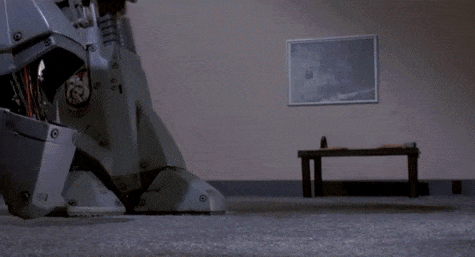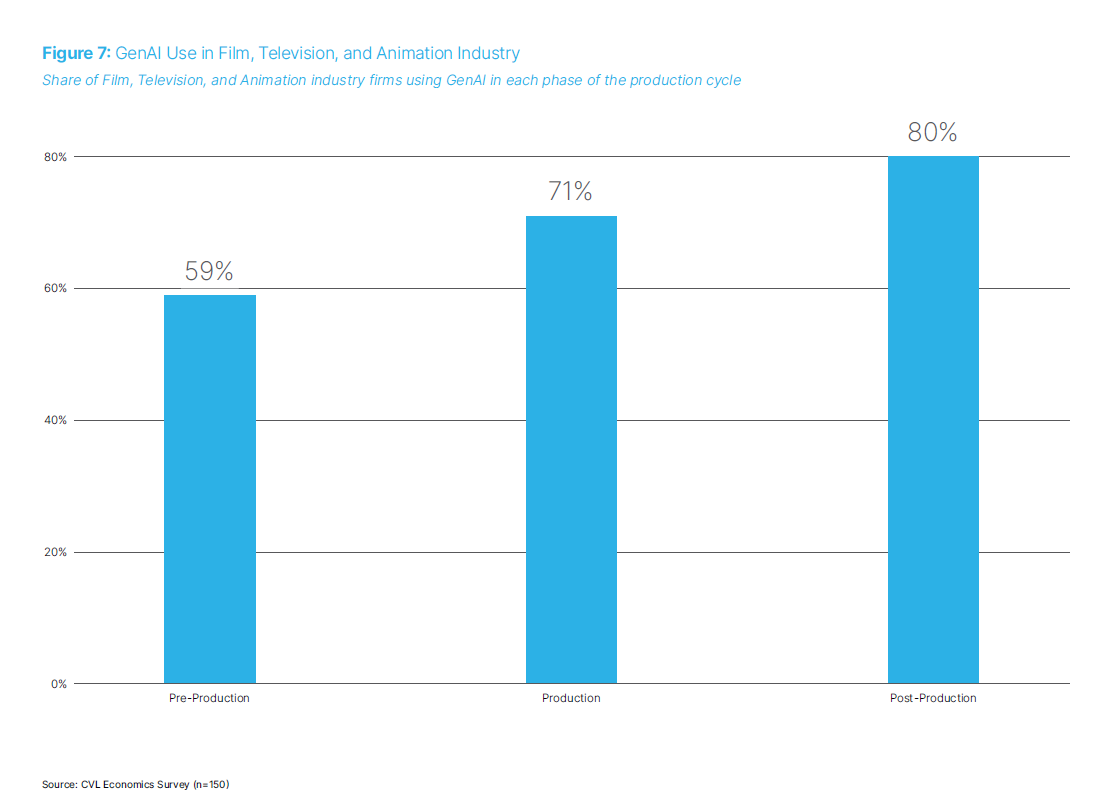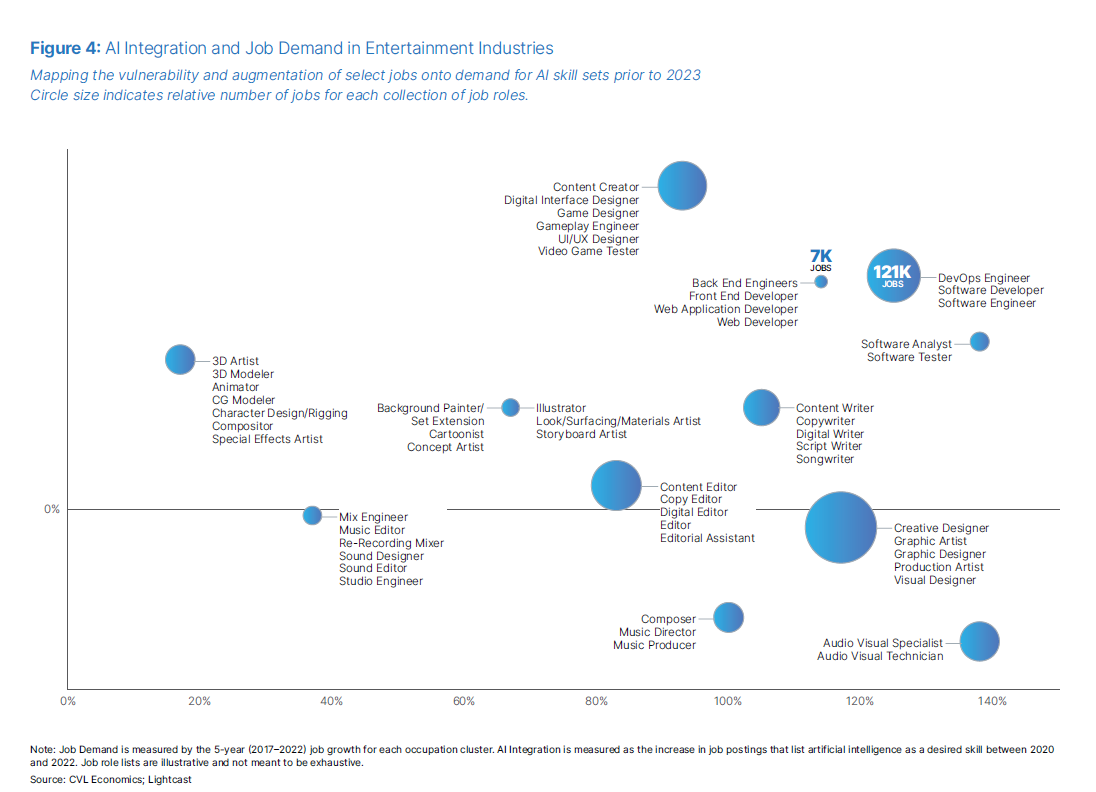
TL;DR
- CVL Economics surveyed 300 leaders in the entertainment industry about generative AI to investigate how uptake of the technology will likely affect M&E jobs in the near term.
- A number of job functions are projected to be especially vulnerable: sound designers, 3D modelers and foreign language dubbers. Also at high risk: Those seeking entry level positions and contract work. Writers and vocal/music performers are expected to fare better, at least in the near term.
- However, the associations that commissioned the study intend to use the information to fight back against the negative impacts of Gen AI uptake during their upcoming contract negotiations.
Do you think your job is safe in the age of Gen AI? I have some not-so-great news for you: Your boss’s boss probably doesn’t agree.
That’s according to CVL Economics’ new report: Future Unscripted: The Impact of Generative Artificial Intelligence on Entertainment Industry Jobs, commissioned by The Concept Art Assn. and the Animation Guild.
In Q4 2023, the consultancy surveyed 300 entertainment business leaders to assess how generative AI will likely affect the M&E workforce.
Respondents represented six sectors: the film, television, animation, music and sound recording and gaming industries. About two-thirds of those questioned agreed implementation of Gen AI is likely to “play a role in consolidating or replacing existing job titles,” according to the study.
Generative AI has come to the forefront of the public imagination “[a]t a time when several entertainment industries are facing challenges,” the report notes, adding that “the desire to increase productivity, cut costs, and identify new revenue streams will be top of mind.”
But the good news is that a majority of respondents said, “GenAI has already led to the creation of new job titles and roles in their organization and anticorporate GenAI technology will be responsible for the creation of new job opportunities.” (But that’s no guarantee that the scales will ultimately balance for workers in any industry.)
For context: “[T]he pace of AI integration into creative job roles is increasing at a rapid clip; between 2020 and 2022, for example, the number of job postings that listed the ability to use artificial intelligence tools as a desired skill increased by 122%,” The Hollywood Reporter’s Winston Cho points out in his coverage of the report.

CVL writes: “[C]reative workers will be facing an era of disruption, defined by the consolidation of some job roles, the replacement of existing job roles with new ones, and the elimination of many jobs entirely.
But We’re Not Taking This Lying Down
Disney Animation Technical Director Brandon Jarratt, who serves on the Animation Guild’s executive board and AI task force, told the LA Times’ Christi Carras that Local 839 will use the study to inform strategy and goals for upcoming negotiations.
The Animation Guild is not the only M&E union likely to follow the blueprint laid out by the WGA and SAG. CVL notes 8% of jobs in the arts, design, and entertainment have representation and collective bargaining. That figure is higher when you narrow it down to the motion picture and sound recording industries (17%) and broadcasting (11%).
CVL concluded that “[c]reative industry leaders are largely embracing GenAI technology, and most recognize that operational benefits in the future will come at a cost to many creative workers.”
The Animation Guild, Jarratt told Carras, aims to “help set the industry standard for what kind of tools are appropriate and … going to help artists, and which ones are going to hurt them and hurt their livelihoods.”
After all, “[t]he tool itself is almost never the issue,” Jarratt explained to Carras. “The studios are always looking for ways to spend less money. And if they feel like they’re going to be able to cut budgets in order to meet shareholder projections or whatever, then they’re going to try to exploit that in any way they can — and that’s where the fear comes from.”
Lest you think that fear is overblown: In November, DreamWorks founder Jeffrey Katzenberg predicted that Gen AI will replace up to 90% of film animation jobs, THR’s Cho notes.
“We’re seeing a lot of role consolidation and reduction,” Concept Art Assn. co-founder Nicole Hendrix told Cho. “A lot of people are out of work right now.”
READ MORE: The Hollywood Jobs Most At-Risk From AI (The Hollywood Reporter)

Click here to view a larger version of the graphic.
Who’s (Most) at Risk?
As a whole, the media and entertainment industry seems more inclined to embrace generative AI — and more likely to be early adopters. CVL reports that 25% said they are currently using some kind of Gen AI, and nearly half (47%) indicated they are planning to implement generative AI soon, in some fashion.
CVL calculated that Gen AI is likely to disrupt “approximately 203,800 payroll jobs” in the US.
In the parlance of the study, a “job is considered disrupted when a significant amount of tasks within that role are consolidated, replaced or eliminated as a result of AI,” per Carras.
She writes, “In an industry already brought to its knees by the COVID-19 pandemic, overspending during the streaming wars, overlapping labor disputes and mass layoff-inducing corporate mergers, AI is just one more wrench to worry about for entertainment workers.”
READ MORE: Which entertainment jobs are most likely to be disrupted by AI? New study has answers (LA Times)
“Among the top tasks flagged as likely to be impacted by AI: creating realistic sound design for film, TV or games; developing 3D assets; and creating realistic sounding foreign-language dubbing. The tasks least likely to be affected include writing film, TV or game scripts, as well as performing music or vocals,” Cho summarized.
Note that more than half of those expected to be affected reside in a handful of U.S. states: California, New York, Georgia and Washington (places known for their connections to film, television and gaming).

Click here for a larger version of this graphic
They also point out that gig workers and freelancers are likely to be hit hard by the incorporation of AI tools; they concede that “change may not be systematically understood or visible beyond anecdotal data” for these types of workers.
Still, it’s worth pointing out, since the report estimates that 29% of U.S. arts, design, entertainment and media workers are self-employed or operate in a similarly independent fashion, more than four times the national average for all major occupation sectors.
CVL tried to suss out the impact by comparing the firms that lean heavily on freelancers with their attitudes toward early Gen AI adoption, and there was an overlap for nearly 8 in 10 companies.
Also likely to be on the Gen AI chopping block are entry level positions, which will have downstream effects on the talent pool. The report frets that this in turn will limit networking opportunities and the acquisition of “domain knowledge,” which are cumulative.
“When you’re looking at any technology that’s essentially replacing [or consolidating] a junior or entry-level role … it is harming the ecosystem,” The Concept Art Assn.’s Hendrix told Carras. “What does that mean if nobody’s really entering in and the bar is now this immovable wall?”
And unless firms are especially careful, DEI initiatives are likely to suffer, CVL cautions.
“Aspiring workers from less affluent and underrepresented backgrounds have historically leveraged these entry-level roles as a pathway into the entertainment industries and to higher-paying positions,” Cho writes.
However, all of these outcomes are not inevitable (except, perhaps the integration of generative AI into nearly every workflow in the same way that the Internet has permeated our lives). Understanding trend lines is not synonymous with seeing an unchangeable future. Unions and regulatory bodies will have a say in how this plays out, in addition to corporations and creatives.
As Cho puts it: “The future is not yet written, and it needn’t be generated by AI.”


